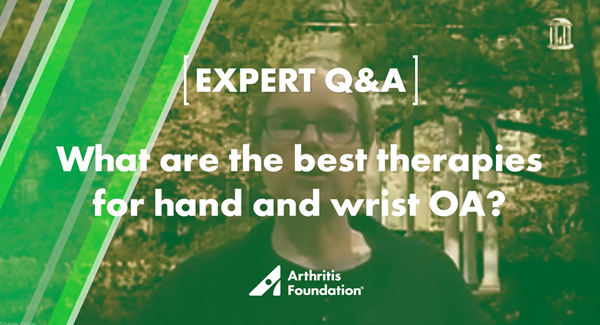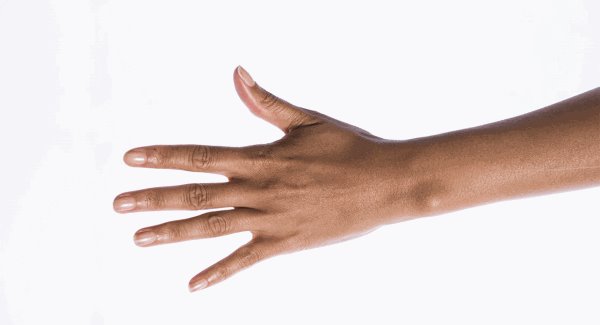Osteoarthritis of the Hands
Get more information about the causes, symptoms and treatments of hand OA, which is very common and can be debilitating.
Updated Oct. 14, 2021
About half of all women and one-quarter of all men will experience the stiffness and pain of osteoarthritis (OA) of the hands by the time they are 85 years old. A degenerative disease that affects all the tissues of a joint, OA leads to the breakdown over time of the smooth, protective cartilage on the ends of bones, so bones rub together, causing pain. The 29 bones of your hands and wrists come together to form many small joints that can be affected by OA.
Hands are complex. Osteoarthritis can affect many small joints in different ways. This article explains what happens inside the hands when cartilage wears down and why pain and stiffness appear. The information is detailed, but the language stays clear and easy to follow. You can help someone feel informed and supported. Give today.
Where OA Affects the Hand
OA most commonly affects three parts of the hand:
- The base of the thumb, where the thumb and wrist join (the trapeziometacarpal [TMC] or carpometacarpal [CMC] joint)
- The joint closest to the fingertip (the distal interphalangeal [DIP] joint)
- The middle joint of a finger (the proximal interphalangeal [PIP] joint)
Causes of Hand OA
Osteoarthritis usually occurs later in life, with no specific cause. But several factors can play a role, including:
- Age: the older you are, the more likely you are to have hand OA.
- Sex: women are more likely to be affected than men.
- Race: whites are more often affected than African Americans.
- Weight: obese people are more likely to have hand OA than thinner people.
- Genes: some people inherit the tendency to develop osteoarthritis, usually at a younger age.
- Injuries: Even when properly treated, an injured joint is more likely to develop OA over time. Fractures and dislocations are among the most common injuries that lead to arthritis.
- Joint issues: Joint infections, overuse, loose ligaments, and poorly aligned joints can also lead to hand or wrist arthritis.
Symptoms of Hand OA
Along with cartilage loss, OA also causes bone spurs to form. Bone spurs in and around the joints increase your stiffness and pain. With worsening OA, daily activities can become difficult and your finger joints may lose their normal shape.
Symptoms of hand OA can include:
Symptoms of hand OA can include:
- Pain: At first, pain will come and go. It worsens with use and eases with rest. Morning pain and stiffness are typical. As the osteoarthritis advances, the pain becomes more constant and may change from a dull ache to a sharp pain. It may start waking you up at night.
- Stiffness and loss of motion: As arthritis progresses, you may lose the ability to open and close your fingers completely.
- Crepitus: When damaged joint surfaces rub together, you may feel grinding, clicking or cracking sensations.
- Swelling: Your body may respond to constant irritation and damage to the tissues surrounding the joint by swelling and becoming red and tender to the touch.
- Nodules: Bony lumps may form on the middle joint of the finger (Bouchard’s nodes) or at the joint near the fingertip (Heberden’s nodes).
- Joint deformity: Bone changes, loss of cartilage, unstable or loose ligaments and swelling can make your finger joints large and misshapen.
- Weakness: The combination of joint pain, loss of motion and joint deformity can leave your hands weak. Activities that once were easy, such as opening a jar or starting the car, become difficult.
Diagnosing Hand OA
Your doctor will examine how your hands look and work and may check other joints for signs of arthritis. X-rays may show loss of space in your joints – indicating cartilage loss – and formation of bone spurs. She’ll make a diagnosis by combining this information with your medical and family history.
Treatments for Hand OA
Osteoarthritis is a chronic disease. There is no cure, but healthy lifestyle habits and treatments can help manage your symptoms and keep you active.
- Non-Drug Treatments: Reducing strain on joints with a splint or brace, adapting hand movements, doing hand exercises or using hot or cold therapy can help to ease pain.
- Drug Treatments: Medicines to ease OA symptoms are available as pills, syrups, creams or lotions, or they are injected into a joint. They include pain relievers like acetaminophen, counterirritants like capsaicin or menthol and non-steroidal anti-inflammatory drugs (NSAIDs) and corticosteroids.
- Surgical Treatments: If medications or self-care activities fails to give relief, surgery may be an option. An orthopaedic surgeon can remove the damaged cartilage and fuse bones together or replace the damaged joint with a plastic, ceramic or metal implant.
Clear explanations can ease worry and replace uncertainty with understanding. Your generosity helps ensure this helpful resource stays within reach for anyone who needs answers.
Hello,
Diagnosed With Osteoarthritis?
Get the latest news and tips about living with OA in the Living Your Yes! e-newsletter.


